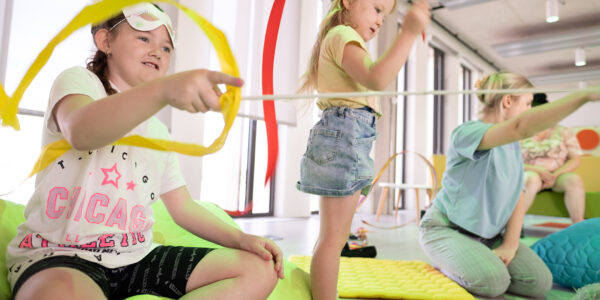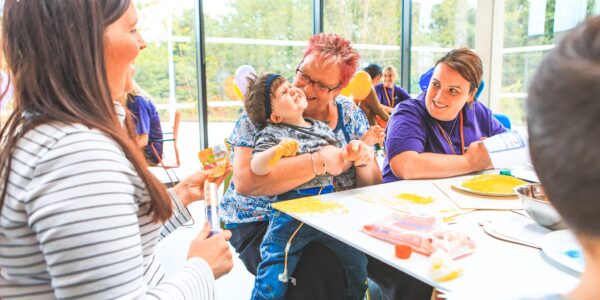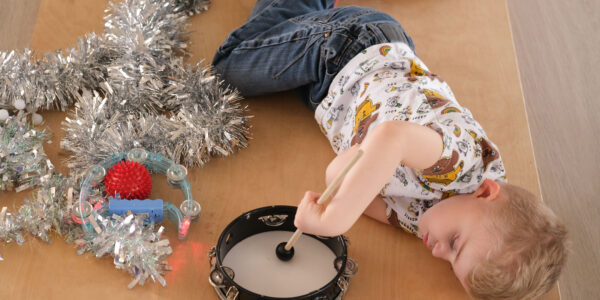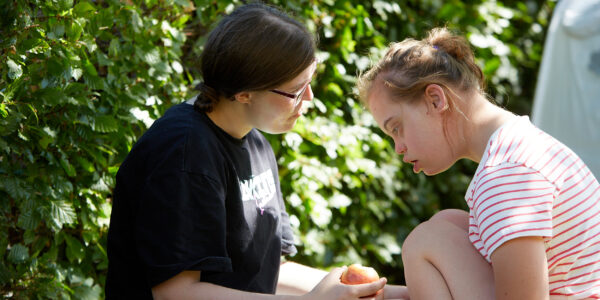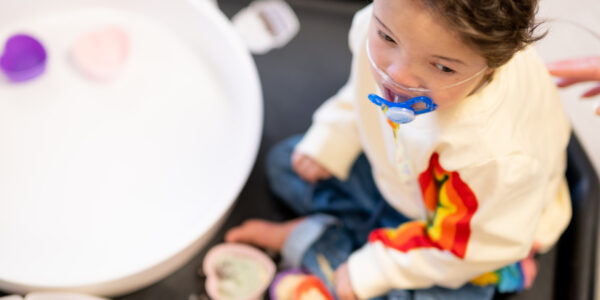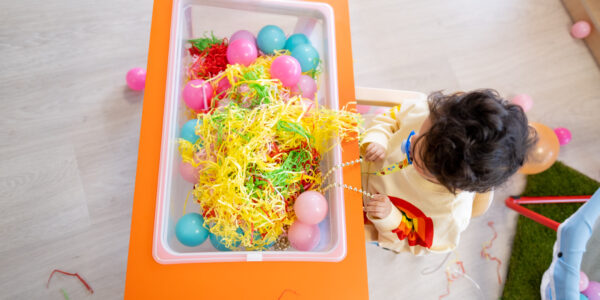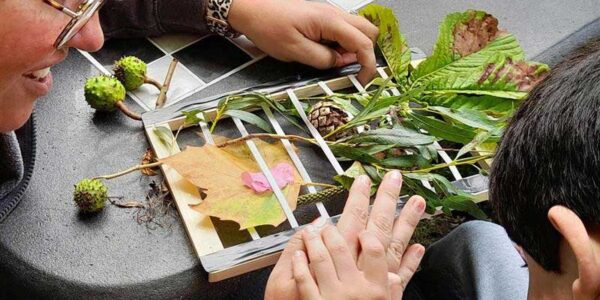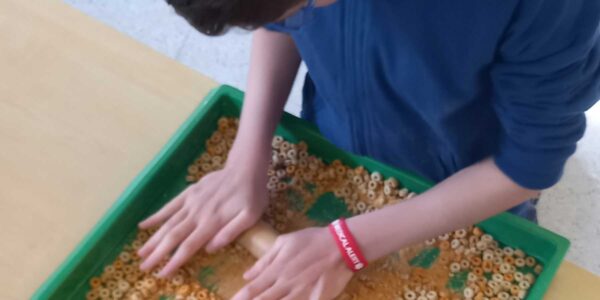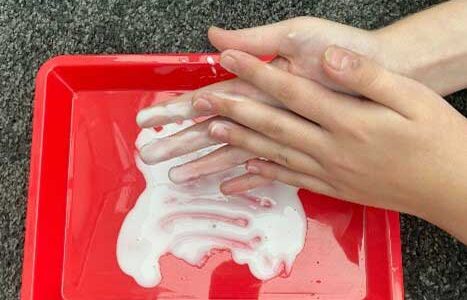How to play with your disabled child
Sense is here for you at every stage of life
From our free play sessions for children under eight, to our adult residential care services, we’re with disabled people and their families every step of the way.
Get in touch with our team to find out how we could support you.
Play for disabled children is just as important as it is for any other child.
In this section, find more information about how to approach playtime when you have a child with complex disabilities, and links to fun activities for disabled children.
On this page:
Why is play important?
Play brings joy and laughter, creating happy memories for all the family.
It also helps children engage with their surroundings, develop communication skills and self-awareness, and connect with others. It’s a fundamental part of childhood and, of course, it’s a lot of fun!
Here at Sense, we know that many toys, equipment, playgroups and playgrounds are not accessible to children with complex disabilities such as multi-sensory impairment (MSI).
The good news is there are countless ways your child can enjoy playing.
Activities for disabled children
General tips for playing with a disabled child
Before you start
- Make sure you and your child are comfortable before beginning an activity.
- All kids do things differently. Give your child time to respond and explore.
- Be in the moment.
- For children who are sensitive to touch, it may be helpful to introduce activities with their feet.
- Less is more. Take things slowly and avoid sensory overload.
- Be adventurous with play.
- Play must always be supervised.
- Be aware of allergies, sensitivities and choking hazards.
Let your child lead
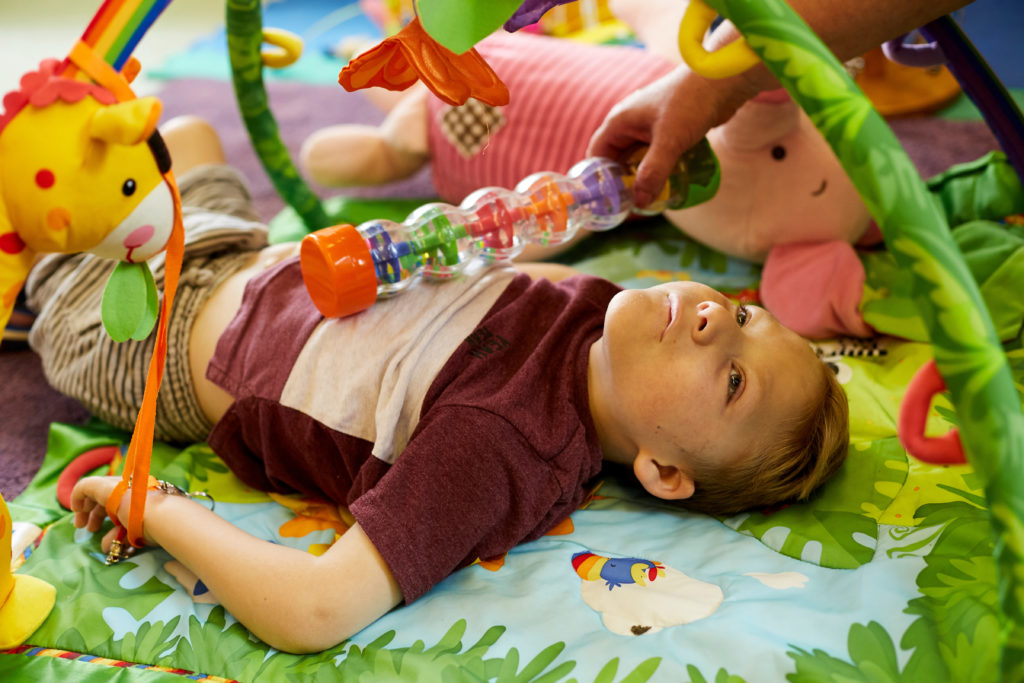
As adults, we can find it difficult to play. But you have the best teacher to guide you: your child!
Try not to get hung up on rules and goals. If your child wants to dress a car up with a hat instead of pushing it, go with it.
Follow where your child leads, even if it differs from your aim. It’s the process that’s important.
Playtime will be more rewarding for both of you if you don’t get attached to an outcome.
Give your child choice
That can be as simple as asking if they want the red or blue crayon. It could also mean offering more complex choices, such as the order to take turns in a game.
By allowing your child to lead, you’ll also learn what your child likes and dislikes. It can also inspire youngsters to explore and express ideas in their own individual way.
Making choices will help your child develop communication skills, confidence, independence and a sense of self, so when your child communicates their preference, always praise them for it.
Use hand-under-hand

This is where your hand performs the activity as your child’s hand rests on top of yours.
Make it sensory
Senses enrich life and are vital to how we develop reasoning, intelligence, language and memory.
Through taste, smell, touch, vision and hearing we learn about the world around us and become more engaged with the activities that we try.
Children with sensory, learning or physical disabilities may struggle to access information.
Those who experience difficulties processing sensory information may choose to avoid certain experiences.
Play helps to introduce new sensory stimulus in an accessible and entertaining way.
Avoid instructing your child on how to engage with activities. Children find their own way to enjoy sensory play, so let your child explore.
Encourage exploration
Children learn through exploration and experience. Much of this takes place through play, where children can be creative, take risks and make discoveries.
Adapt and make toys
Mainstream toys aren’t always accessible to disabled children and buying sensory toys can be expensive, but you can make simple changes to standard toys to make them more suitable for your child.
You can also make toys out of everyday household items.
Remember that anything homemade or adapted should always be used under supervision.
Never leave a child alone with an adapted or homemade toy. Be aware of anything that could come off and become a choking hazard.
Tips on adapting and making toys
- Keep it simple.
- Tailor it to your child’s needs.
- Try adding a tactile element.
- You may want to enlarge features to make it easier for your child to interact with.
- Think about whether there are any unnecessary features or distractions that can be removed.
- Pots, pans with lids, and a choice of wooden spoons can be used to make noise.
- Add ‘clean mud’ (tissue paper and brown paint) to pots and pans for messy play.
- Items like sieves can be fun to look through.
- Fill rubber washing up gloves with beans or liquid cornflour.
- Put some bells in a secure bag and squeeze into a kitchen whisk to create a shaker.
Make play inclusive for siblings, too
Children connect and bond through play and there are lots of ways of encouraging this.
You can adapt activities to include turn-taking. For example, children can take turns to tap rhythms on a resonance board or roll tactile balls across a board or floor to each other.
Tailoring play to include the way your child communicates is important. Learning to communicate as a family is a great bonding experience, especially for siblings.
Play activities can include both informal and formal communication methods.
Remember: inclusion should work both ways. It allows children to get involved in each other’s favourite activities and create new things together.
Playing outside your home
Most of the tips and techniques in our toolkit can be enjoyed away from home with little or no adaptation.
Whether you’re visiting friends and family or heading outdoors, consider taking some of your play accessories with you.
Outdoor play is essential to the healthy physical, social and emotional development of all children.
Having an awareness and connection with nature enhances appreciation and wellbeing for children and adults alike.
Children with complex disabilities especially receive help from exploring sights, smells, textures and sounds in natural environments. The opportunity to play freely helps to develop confidence and self-esteem, too.
The play activities described in this toolkit can all be enjoyed outdoors. For example, messy play using sensory trays can be great fun outside.
Simply being out in the open air can be very relaxing, which is important for both you and your child.
- On a warm day, lay your child down on a blanket, under a tree.
- They can look at the leaves, hear them rustle, and feel the breeze in the shade. Lie down with your child too, if it’s possible.
- Try hanging different coloured scarves, textured materials or wind chimes on the branches, if your environment allows.
- Set up a choice of sensory trays, each with a different theme, for your child to explore.
- If you have a private outdoor area, think about leaving these outside at the end of playtime so you can come back to them another time. This creates open-ended play.
Try a sensory tray for outdoor play for children who are less mobile or keen to explore.
Playing in hospital
- If your child is spending time in hospital, think about what play resources could be made available.
- Doctors, nurses and therapists appreciate the importance of play, so are likely to be open to facilitating suitable activities that will be engaging and rewarding for you and your child.
- The hospital play worker or therapist will be able to provide toys that are suitable for your child. It might also be possible for your child’s favourite toys to be brought to the ward from home if protocol allows this. Ask if in doubt.
- Remember that anything brought into the hospital needs to be reviewed for suitability in a sterile environment. It’s also best to avoid toys that need to be plugged into an electrical socket.
- It may not be possible to bring lots of toys to the ward but there are practical nursing items that can be adapted to make excellent sterile playthings. For example:
- Blow up a rubber glove and draw a face on it or fill it with water.
- Try tapping rhythms on a disposable paper bowl.
- Survival blankets are shiny, have an interesting texture and make a nice sound. You can take turns scrunching a corner.
- ‘I’ve been GOOD!’ (or similar) stickers can make you very popular!
- ‘Beads of Courage’ recognise your child’s journey and can support them to talk about it. Visit the Beads of Courage website to find out more.
- If your child needs a quiet space, it is always worth asking if a room is available.
- Add ‘clean mud’ (tissue paper and brown paint) to pots and pans for messy play.
- Items like sieves can be fun to look through.
- Fill rubber washing up gloves with beans or liquid cornflour.
- Put some bells in a secure bag and squeeze into a kitchen whisk to create a shaker.
Your child’s right to play
We want to make sure that you, as parents, know your rights and understand what you and your child are legally entitled to.
There are legal requirements around play for disabled children, set out in the Equality Act 2010. It gives legal protection to disabled children and families looking to access play services.
Public bodies that provide play facilities must also comply with the public sector equality duty set out in the Equality Act 2010, for example.
The Equality and Human Rights Commission gives guidance on its website about legal requirements in relation to discrimination, reasonable adjustments and the public sector equality duty.
Risks, health and safety
Health and safety are important and must always be considered.
At Sense we recognise that achieving a balance between protecting children from serious risk and allowing them to reap the benefits of play isn’t always easy. We also know that the opportunity for play develops a child’s risk awareness and prepares them for their future lives.
Play allows children to explore and understand their abilities. It helps them to learn and develop while exposing them to the realities of the world in which they will live. While it may be impossible to completely eradicate even the smallest danger, constant supervision and awareness of potential hazards help to manage the risk.
Get support from Sense
If you have a child with complex disabilities and would like support from Sense, please reach out to our friendly team.
This content was last reviewed in October 2023. We’ll review it again next year.


